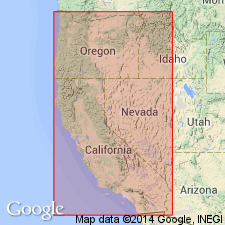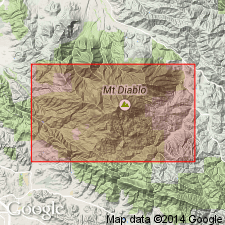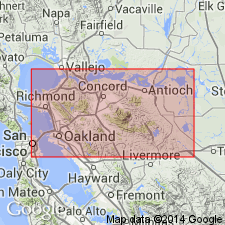
- Usage in publication:
-
- Diablo formation
- Modifications:
-
- Named
- Biostratigraphic dating
- Dominant lithology:
-
- Mudstone
- AAPG geologic province:
-
- California Coast Ranges province
Summary:
Named for excellent exposures near Diablo post office, southwestern slope of Mount Diablo, Contra Costa Co, CA. Formerly called "Alamo formation" by Clark (1940). [Also new name listed in Clark (1944)]. Contains marine fauna showing affinities with early Pliocene Jacalitos [Stage] (Clark, 1935 p.1035). Well preserved flora occurs in brown semi-cherty mudstone near base. Abundance of PERSEA [flora] and absence of semiarid species indicate warmer and moister climate than that of following Black Hawk Ranch Stage.
Source: GNU records (USGS DDS-6; Menlo GNULEX).

- Usage in publication:
-
- Diablo formation
- Modifications:
-
- Named
- Dominant lithology:
-
- Sandstone
- Conglomerate
- Shale
- AAPG geologic province:
-
- Sacramento basin
Summary:
Diablo formation is new name for Alamo formation [of Clark (1940) south side of Mount Diablo, Contra Costa Co, CA]. Consists of coarse arkosic sandstone, heavy conglomerate in lower part composed mostly of andesitic boulders with lenses of conglomerate higher up, and thin layers of shale carrying abundant leaf impressions. Is about 1000 ft thick. Shown on chart as unconformably overlying Neroly formation and [unconformably] underlying Green Valley formation. Age shown as early Pliocene.
Source: GNU records (USGS DDS-6; Menlo GNULEX).

- Usage in publication:
-
- Diablo Member
- Modifications:
-
- Revised
- Age modified
- AAPG geologic province:
-
- California Coast Ranges province
Summary:
Diablo formation of Clark (1944) is regarded as transitional member (Diablo Member) of "Neroly" Formation (F.H. Kilmer, 1953, unpub MA thesis, UC Berkeley). Mudstones and finer sandstone contain shallow-water marine or brackish invertebrate fossils and closely resemble typical "Neroly" Formation. Intercalation of beds containing Diablo flora indicate transition (delta-estuary complex) from marine to continental deposition. [Black Hawk Ranch fauna of overlying Green Valley Formation now considered Miocene (Savage and Russell, 1983); therefore Diablo Member would be Miocene age.]
Source: GNU records (USGS DDS-6; Menlo GNULEX).
For more information, please contact Nancy Stamm, Geologic Names Committee Secretary.
Asterisk (*) indicates published by U.S. Geological Survey authors.
"No current usage" (†) implies that a name has been abandoned or has fallen into disuse. Former usage and, if known, replacement name given in parentheses ( ).
Slash (/) indicates name conflicts with nomenclatural guidelines (CSN, 1933; ACSN, 1961, 1970; NACSN, 1983, 2005, 2021). May be explained within brackets ([ ]).

